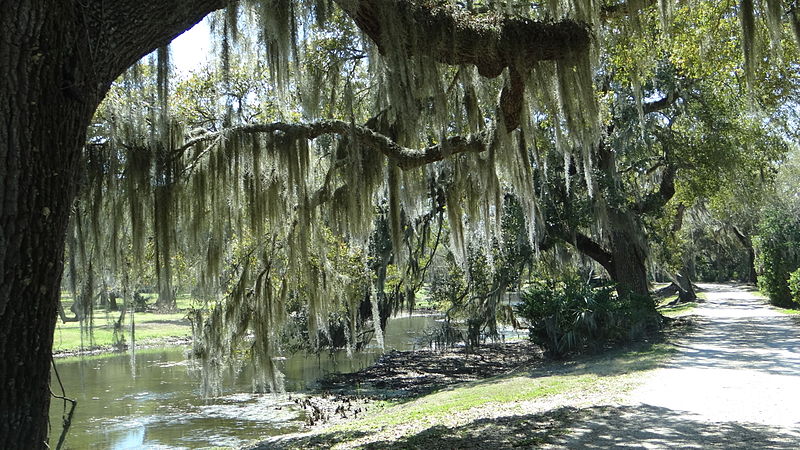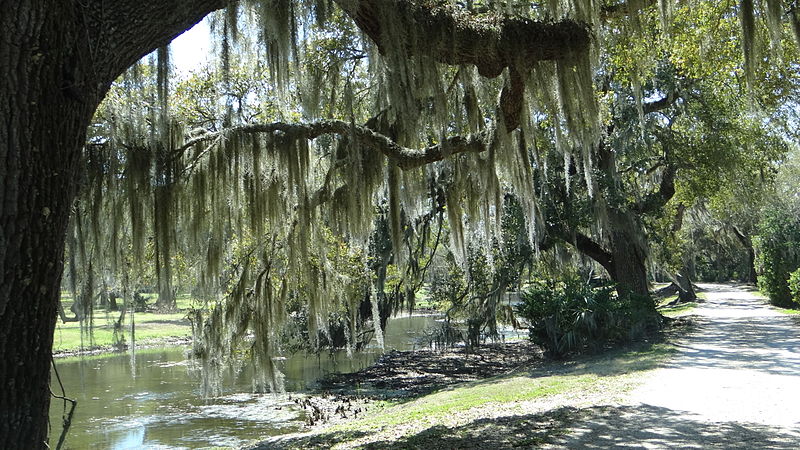
Avery Island, Louisiana
Numerous procedures can be used to maintain the environmental integrity of drilling sites and the surrounding area. Extremely fragile areas, such as marshes, can be protected through directional drilling, a technique that allows drilling on a site at some distance from the target. The Petite Anse 82 well on Avery Island, which is privately owned by the Mcllhenny family, was drilled vertically for about a mile, then angled horizontally for about twelve thousand feet to protect the surface environment. At the drilling site, the drilling fluid used to lubricate the drill bit and circulate rock cuttings to the surface also sealed off and protected the penetrated rock strata from contamination, as well as controlled pressures in the well. Protective pipe and casing were used to prevent contamination of aquifers and other strata within several hundred feet of the surface. The space between the casing and the rock sides of the hole was filled with cement to prevent communication between strata, ensuring that fresh water zones were not damaged by zones containing saline water.
From “Ecology and Energy,” Free Market Environmentalism, by Terry L. Anderson and Donald R. Leal
(San Francisco: Pacific Research Institute, 1991), p. 88.
Last spring, Reid Lea, a petroleum engineer who is studying for a doctorate in environmental engineering at Louisiana State University, took a course in natural resource economics. Dean Lueck (a former Murdock Fellow at PERC) was the instructor. One assignment was to write a book report of Free Market Environmentalism by Terry L. Anderson and Donald R. Leal. This excerpt from Lea’s book report tells a fascinating story.
As I read the chapter titled “Ecology and Energy,” I was surprised to find that I had unknowingly played the role of free market environmentalist. In this chapter, the authors described how the interests of environmentalists and oil explorationists are needlessly pitted against each other due to inadequate property rights. On page 88, Anderson and Leal described how an oil well was successfully drilled in an environmentally sensitive marsh.
As the engineer who proposed and drilled that well, I did not realize at the time that well-defined rights caused me to act in a self-interested manner that also protected the environment. Following is a description of how this occurred.
Avery Island is located adjacent to the Louisiana Gulf Coast approximately one hour south of New Iberia. The “island” is actually the result of a subterranean salt intrusion which caused a few square miles of land to rise 200 feet above the surrounding marshes. The land has been owned by two families, the Mcllhennys and the Averys, since the Civil War. The surrounding marsh and waterways are owned by the State of Louisiana. Oil was discovered in the area during the 1940s.
Avery Island is the home of the pepper fields, salt mine and bottling plant where Tabasco sauce is made. It is also a private bird and wildlife sanctuary as well as a national historic area. The island is a tourist attraction that generates a handsome annual income for the landowners. The families are interested in maintaining the aesthetic appeal of their property.
On one half of the island, access to oil drilling is gained via waterways controlled by the State of Louisiana. The Mcllhenny and Avery families share in the oil production from this area because of unitization; however, they do not control the oil companies’ dredging and drilling operations. Drilling permits are issued at the discretion of the state.
Oil production on the other half of the island is above sea level and access is strictly at the discretion of the landowner. The state will issue permits to drill only after the landowner and the exploration company have entered into a contractual agreement. On this side of the island, the State of Louisiana shares in production as a result of unitization of the wells.
In 1980 or 1981, I proposed that my employer, a large oil company, drill six new wells on the eastern flank of the island in the area controlled by the Mcllhennys and Averys. In spite of the long relationship with the company, the families were concerned about potential damage to their land. Their concerns arose from recent uncontrolled drilling in the marsh areas under the state’s control. The area in which I proposed to drill was particularly sensitive because it was in the middle of the Tabasco pepper fields and adjacent to the island’s egret rookery. Nonetheless, both my company and the landowners had an economic self-interest in resolving the problems and commencing drilling operations.
The oil company eventually agreed to build a twoacre drill site of specially treated lumber. All of the wells were to be drilled directionally from the same pad to be located in the middle of the pepper fields. When the drilling was completed two years later, all parties were happy with the results. Several highly productive wells had been completed and little or no residual environmental impact was created.
As I read in the book, I realized that the forces of free market environmentalism had been at work. I was anxious to allay the landowners’ concerns so that the company I worked for could drill the wells I had proposed. If drilling in a certain manner cost more money (and it did), then it was my job to determine if my employer could still make a profit (it could).
The alternative was not being able to gain access to the oil reserves. The landowners were anxious to earn the royalties from additional oil production, but only if the result was a net gain after taking into account the impact on the Tabasco and tourism businesses. The landowners were rightfully concerned about their property, especially since it had previously been damaged by the drilling taking place on the state-controlled water bottoms immediately adjacent to their property.
It is particularly interesting to know that I was the engineer proposing and drilling the wells on both sides of the island. On one half of the island, the landowner (the State of Louisiana) had no particular interest in maintaining environmental amenities on the land which it did not own. I had no economic incentive to spend the additional funds to minimize the environmental impacts. In having the authority to issue the drilling permits, the state could externalize the environmental impacts. On the other side of the island, I had to minimize or mitigate the effect of drilling on the environment because of the clear property rights. The oil company willingly incurred the extra cost of drilling because of its economic self-interest, not because of environmental concern. Only upon reading the book did I realize how my actions were influenced by the different property rights regimes.
This example clearly demonstrates the central point Terry Anderson and Don Leal make in the book Free Market Environmentalism. The authors present a convincing argument that resource misallocation and environmental degradation result from inadequate or nonexistent property rights.
Well-defined property rights, in contrast, are a key incentive in creating and maintaining the value of environmental amenities and natural resources.



